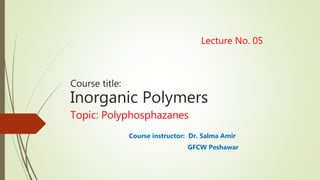
Polyphosphazenes... preparation and properties by Dr. Salma Amir
- 1. Lecture No. 05 Course title: Inorganic Polymers Topic: Polyphosphazanes Course instructor: Dr. Salma Amir GFCW Peshawar
- 2. Polyphosphazenes Polyphosphazenes comprise by far the largest class of inorganic macromolecules. At least 700 different polymers of this type have been synthesized, with a range of physical and chemical properties that rivals that known hitherto only for synthetic organic macromolecules Most polyphosphazenes have the general molecular structure shown The polymer backbone consists of alternating phosphorus and nitrogen atoms, with two side groups, R, being attached to each phosphorus. The side groups may be organic, organometallic, or inorganic units. Each macromolecule typically contains from 100 to 15,000 or more repeating units linked end to end, which means that (depending on the organic side groups) the highest molecular weights are in the range of 2 million to 10 million.
- 3. Types Polyphosphazines, [NPR2]n in which R = CI, OCH3 or OC2H5. Polyphosphazines may be of three types namely (a) Polyphosphonitrilic chlorides, [NPCI2]n (b) Polydimethoxy-phosphazines, [NP(OCH3)2]n (c) Polydiethoxy-phosphazines, [NP(OC2H5)2]n
- 4. Synthesis of polyphosphazane Linear poly(organophosphazenes) are now synthesized by Ring opening polymerization Condensation polymerization
- 5. 1. Ring opening polymerization The synthesis of (NPCl2)n typically involves the thermal ring opening of hexachlorocyclotriphosphazene (HCCP) (NPCl2)3 under vacuum at 250°C for 3 h in high-boiling organic solvents, such as one of the di- or trichlorobenzenes, or neat at about 2500C Careful reaction control is required to obtain a soluble linear polymer. Lewis acid catalysts, for example, anhydrous aluminum chloride, catalyze this ROP. Less time or a lower temperature is needed. thermolysis also produces (NPCl2)n (n ≥1000). A suitable nucleophilic reagent, for example, the sodium salt of an alcohol or phenol
- 7. Ring opening mechanism In this mechanism it is assumed that polymerization is induced by ionic species, generated by the ionization of P-Cl bonds to form a cyclic (or linear) phosphazenium ion. The phosphazenium ion would then act as a cationic initiator by attack on the skeletal nitrogen atom of an (NPCl2)3 molecule, inducing ring opening and chain propagation by a cationic mechanism.
- 8. 2. Condensation polymerization Certain condensation polymerizations can also lead to this polymer, which is then used as a macromolecular intermediate for reactions with alkoxides, aryloxides, or amines. Three different condensation processes have been identified, and are Condensation of PCl5 with Ammonia Condensation Reactions of OCl2PN=PCl3 Condensation Polymerization of Organic Substituted Phosphoranimines
- 9. a. Condensation of PCl5 with Ammonia The reaction between phosphorus pentachloride and ammonia or ammonium chloride proceeds in a stepwise fashion, as shown in reaction sequence , by elimination of hydrogen chloride first to form a monomer (3.40), then a linear dimer (3.41), trimer (3.42), tetramer, and so on.
- 11. b. Condensation Reactions of OCl2PN=PCl3 De Jaeger and coworkers have carried out extensive studies on the polymerization of the monomer, OCl2PN=PCl3, which is prepared from (a) PCl5 and ammonium sulfate, (b) phosphoroyl chloride and ammonium chloride, or (c) PCl3 and ammonium chloride under oxidative conditions. At 240–290 °C and at atmospheric pressure, this monomer eliminates phosphoroyl chloride, POCl3, and yields poly(dichlorophosphazene). The overall processes are shown in reaction .
- 12. c. Condensation Polymerization of Organic Substituted Phosphoranimines This can be used for the direct production of poly(organophosphazenes). Thus, treatment of N- silylphosphoranimines such as Me3SiN=PCl2R or Me3SiN=PClR2 in the presence of a Lewis acid initiator yields polymers of the type, (NPClR)n and (NPR2)n. [poly(dialkylphosphazenes) and poly(alkyl/arylphosphazenes] Polymers that bear one chlorine and one organic group per phosphorus can, of course, be converted to fully organo-substituted species by treatment with organic nucleophiles. nMe3SiN=PRR/X Me3Si[N=PR2]nX + (n-1)Me3SiX where R is an alkyl group, R/ is an alkyl or aryl group, and X is OCH2CF3 or OC6H5:
- 14. Properties of polyphosphozanes Melting and boiling point: (NPCI2)3; melts at 114° C, boils at 256°C at 1 atm pressure and is readily soluble in benzene, ether and carbon tetrachloride. (NPCI2)4 melts at 123.5°C, boils at 328.5°C and has a lower solubility in benzene, ether and carbon tetrachloride than (NPCI2)3. Toxicity: (NPCI2)3 and (NPCI2)4 are irritating and somewhat toxic also. Cyclic to chain converstion: Cyclic trimer. [NPCI2]3 or tetramer, [NPCI2]4, when heated in vacuum at 250°C gives a chain polymer Biodegradable: Poly(organophosphazenes) offer an appealing platform for the design and synthesis of novel biodegradable polymers as well as critical advantages for the design of biologically functional macromolecules with a broad structural diversity, high functional density, and tailored biodegradability
- 15. Flexible: Polyphosphazenes are hybrid polymers with a flexible inorganic backbone of alternating phosphorus and nitrogen atoms and organic side groups. Their composition vary from 3 to 10,000 (–N=P–) repetitive units having two substituents (–R) attached to the phosphorus atom Modification: It can be modified with ester, anhydride, and unsaturated groups to improve chemical stability and mechanical properties. Effect of light or heat: Polyphosphazenes can be readily crosslinked either by exposure to heat or to ultraviolet light Hard : The polymer is relatively hard, with a glass transition temperature between 60°C and 70°C and a melting point between 170 and 180°C.
- 16. Solubilty: Freshly-prepared (NPCI2]n polymers are soluble in chloroform but insoluble in petroleum ether. When their solution is allowed to stand, (NPCI2]n get cross- linked and slowly gel Elasticity: These polymers exhibit high elasticity and can be stretched several-fold with almost complete recovery. However, they undergo degradation under normal atmospheric conditions more rapidly than do the organic rubbers. Hence these polymers do not find much commercial use. Other properties 1. Polyphosphazenes (PZs) posses special characteristics, including 2. flame-retardant properties, 3. high resistance to oil and solvents, and 4. feasibility for tailored properties according to the choice of organic, inorganic, or organometallic side groups